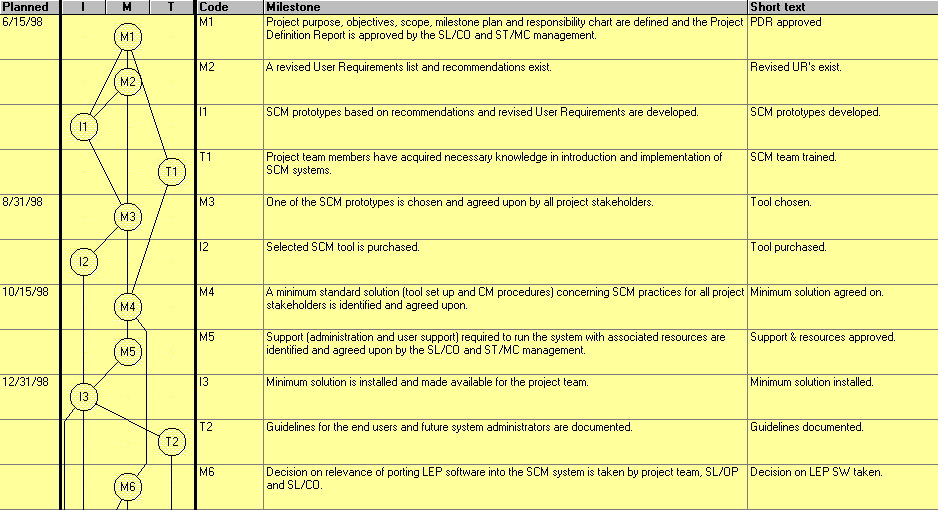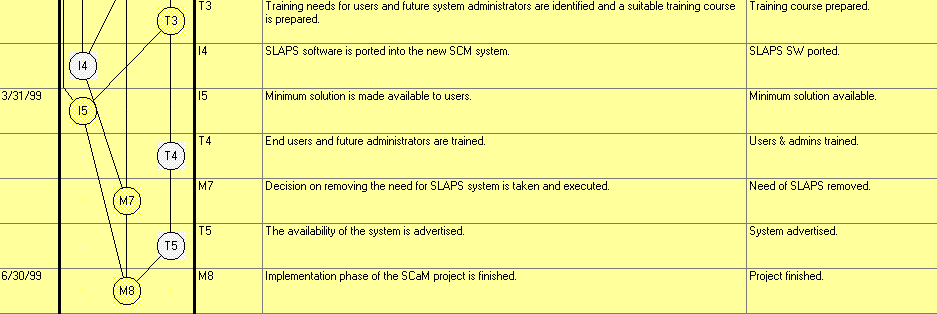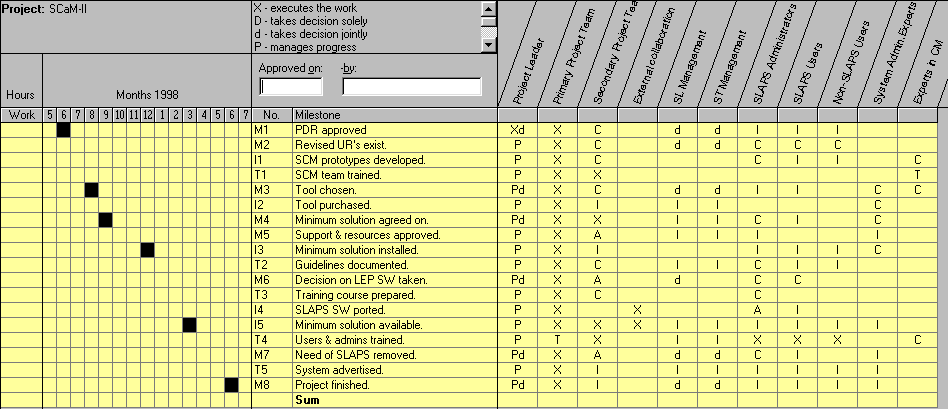SL - ST Software Configuration
and Management System Project
Implementation Phase
Project Definition Report
PDR/MS Word 97/Issue 1 - Revision 1
- June 15, 1998
R. Bartolome, P. Charrue, B. Denis,
E. Hatziangeli, I. Laugier, P. Ninin, V. Paris, A. Risso, H. Sobczak, J.
de Vries
| DOCUMENT STATUS
SHEET |
| 1. DOCUMENT
TITLE :
SL - ST Software Configuration and
Management System Project - Implementation Phase
Project Definition Report |
| 2. ISSUE |
3. REVISION |
4.DATE |
5. REASON FOR
CHANGE |
|
1
|
0
|
June 98
|
First Issue |
|
1
|
1
|
June 98
|
First review
by project team. |
Document prepared by: E. Hatziangeli,
H. Sobczak
1. Preface *
2. Management Summary *
3. Background *
4. Purpose, Scope and Objectives *
4.1 Purpose *
4.2 Scope *
4.3 Objectives *
5. Work Breakdown Structure *
5.1 Project Definition Workshop *
5.2 Implementation phase *
5.2.1 Milestone Plan *
5.2.1.1 Result Paths *
5.2.1.2 Milestones Definition *
6. Project Organisation *
7. Project Management System *
7.1 Project Planning Procedures *
7.2 The Project Team *
7.3 Tools and Documentation *
8. Project Budget *
9. Acknowledgements *
10. References *
Appendix A *
The Project Milestone Plan *
Appendix B *
The Project Responsibility Chart *
1.
Preface
The Project Definition Report (PDR)
is the outcome of the Project Definition Workshop (PDW) between the project
sponsor, the project team and the immediate supervisors of the members
of the project.
The purpose of the workshop was:
-
to clarify and define precisely the purpose,
the scope and the final objectives of the project amongst the project stakeholders,
-
to identify the project team and,
-
to gain the commitment of the project
team.
This document contains a clear description
of the domain of the project, the problems to be solved and the final goals
to achieve that were discussed and agreed in common by the attendees.
Part of the workshop was devoted to:
-
the planning of the work in terms of intermediate
attainable goals (milestones),
-
the estimation of completion dates for
certain important intermediate milestones, as well as the end of the project,
-
the identification of the available resources,
including their level of commitment to the project,
-
the identification of other parties or
projects which are interested in the outcome of this project.
2.
Management Summary
The outcome
of this project will be a new Software Configuration Management (SCM) system
that will replace and add new functionality to the existing SLAPS [R1]
software management system.
The new system will be a set of tools
and procedures that address the entire software lifecycle identifying,
managing and controlling software and software related components as they
change over time. This process will ensure that, at all times, the status
and the locations of all versions of all deliverables are known. The status
of shared objects is carefully controlled and all unauthorised changes
are prevented. It will provide a controlled and managed environment for
software development and it will automate the tasks of code and lifecycle
management.
In May 1997, a PDW was held to define
the start of the overall Software Configuration and Management (SCaM) system
project. The main aim of the SCaM project was defined to be:
Find a software management
system, after conducting an in-depth market survey and evaluation, port
all existing projects, using SLAPS, in the new system and remove the need
of the SLAPS system.
The project was separated in two phases:
-
the survey phase,
-
the implementation phase.
The survey phase was completed by March
1998 and a technical proposal with the evaluation of the recommended SCM
systems was documented in the project's evaluation report [R2].
This PDR refers to the implementation
phase, which will mainly be devoted to:
-
Define a minimum standard SCM solution,
which will be acceptable to all the project stakeholders (SL, ST, PS, LHC),
-
Purchase or implement a tool to support
the new SCM system,
-
Install the SCM system into operation
and make it available for use,
-
Port projects using SLAPS inside the system,
and encourage non-SLAPS users to incorporate their software in this system,
-
Remove the need for the SLAPS system.
There are two teams participating in the
implementation phase:
-
The primary project team is dedicated
to work exclusively on this project and it is composed of:
| Hubert Sobczak
(SL/CO) until Jul. '98 |
| Technical student
(SL/CO) after Nov. '98 |
| Roberto Bartolome
(ST/MC) until Jun.'98 |
| Jose Luis Patino
Esteban (ST/MC) from Aug. '98 |
| Eugenia Hatziangeli
(SL/CO)
Project Leader |
SCaM primary project team
-
The secondary project team is available
for advice and consultation. Work will not be formally attributed to any
member of the secondary team, but they agreed to volunteer their time when
it is available. The members of the secondary team are:
| Roberto Bartolome
(ST/MC) from Jul. '98 |
| Jannes de Vries
(SL/BI) |
| Alessandro
Risso (PS/CO) |
| Isabelle Laugier
(LHC/VAC) |
SCaM secondary project team
The PDR also contains the definition of
the project purpose, scope and objectives for the Implementation phase.
In addition, it contains the strategic
milestone plan and the overall project responsibility chart for this phase.
These documents are techniques defined by the Goal Directed Project Management
(GDPM) method [R3].
3.
Background
The present SLAPS software management
system was developed in CERN in the late ?80s for in-house software development
on the Apollo/DOMAIN system. It is based on C-shell scripts, C programs
and a specific directory structure repository. The main objectives of the
system were to:
-
retain the current and previous versions
of the control system, and versions of all source files,
-
maintain a development environment for
all software development,
-
maintain a testing environment that is
separate from the running control system software.
With the move to HP-UX as the main development
platform and the use of PCs and Power PCs running LynxOS, the system was
extended to allow multiple platform compilation via the use of environment
variables. We are now at the point where the limitations of the present
system are reached. The maintenance of the system itself is very taxing
to the software administrators and extensions of its functionality are
difficult to implement. This, in addition to the lack of proper procedures
to allow the introduction of externally developed software, has led to
the creation of this project.
The first phase (survey) of the project
was completed in March 1998. It has:
-
Revised the functionality of the present
SLAPS system,
-
Identified all users and captured their
User Requirements (URs) [R4],
-
Conducted an in depth evaluation of CERN,
commercial and public domain solutions,
-
Identified and evaluated the impact of
the possible solutions on the present software development,
-
Produce a technical proposal with the
evaluation of the recommended SCM systems [R2].
The PDW for the final phase (implementation)
achieved the commitment of the primary project team and the identification
of a secondary team with direct interests in the outcome of the project.
Common agreement on the purpose, scope
and objectives of the project was reached between everyone involved. Therefore,
this PDR marks the start of the project lifecycle.
4.
Purpose, Scope and Objectives
4.1
Purpose
The purpose of the implementation phase
of the project is to provide a complete software configuration and management
system capable of supporting:
-
Software in the present SLAPS system,
-
Software outside the domain of the present
SLAPS system,
-
Present and future software development
for SPS, PS, LHC/VAC and for the control of CERN technical infrastructure,
-
Future software development by external
contractors,
-
Future technology trends (JAVA).
The new system will solve the following
problems:
-
Documentation management,
-
Software Problem Reporting,
-
User working shell (csh, bash, ksh, etc.)
independence,
-
Common software repository, which will
facilitate the exchange of software between SL/CO and PS/CO [R5],
-
Software Management system for the future
LHC software,
-
Rationalisation of software management
practices,
-
Properly supported software management
service.
The benefits of the new system will be:
-
A simpler system to be maintained by SL
and ST,
-
A single software configuration and management
environment, which will ease the exchange of personnel and the software
development,
-
Development of thorough guidelines concerning
the construction, integration and installation of operational software
and the introduction of software modifications,
-
Transparency of software and information,
-
Platform independent
development.
4.2
Scope
The work necessary to achieve the purpose
outlined above includes:
-
Review of the User Requirements [R4] collected
during the survey phase and the recommendations [R2] made in the end of
this phase, in the light of:
-
Future technology trends (JAVA, Microsoft
Development environment),
-
"Services for computing at CERN" project
[R6],
-
New project stakeholders:
-
SL/BI
-
LHC/VAC
-
PS/SL convergence project [R5].
-
Run a prototype solution based on the
revised recommendations,
-
Obtain agreement amongst all the stakeholders
on which solution to choose from the recommended ones,
-
Identify a minimum standard SCM solution
(tool set-up and CM procedures), which is applicable to all the stakeholders,
-
Identify training needs for the team members,
end users and future system administrators,
-
Identify the necessary resources for the
day-to-day operation and user support of the SCM system,
-
Purchase or implement a SCM tool to support
the minimum standard solution,
-
Install the minimum standard SCM solution,
-
Port SLAPS software into the new system,
-
Evaluate the relevance of porting the
LEP software in the new system, in view of the short LEP lifetime,
-
Make minimum standard SCM solution available
to the users,
-
Remove the need for SLAPS,
-
Develop guidelines and documentation for
end users and future system administrators,
-
Advertise the new system in CERN.
The work of this project does not
cover:
-
The day-to-day operation and user support
of the new system after the facility is delivered and the project is formally
terminated,
-
The introduction of new software projects
in the SCM system, which remains the responsibility of the software owners,
-
The development of guidelines for good
software development, for testability and for operability of production
software.
4.3
Objectives
Identify a minimum standard SCM solution
and gain its acceptance from:
-
SL/CO,
-
SL/BI,
-
ST/MC,
-
PS/CO,
-
LHC/VAC
Install the minimum standard solution,
make it available for use and eliminate the need for SLAPS.
A list of different service scenarios (CERN, Russian collaboration,
commercial companies, etc.) could be used to bring all concerned software
in the new management system.
Non-SLAPS users will be encouraged to incorporate their
software inside this system.
5.
Work Breakdown Structure
|
Phase
|
END DATES
|
OBJECTIVES
|
|
Project Definition Workshop
|
May 1998
|
Production of the project definition
report
|
|
Implementation
|
June 1999
|
New SCM system
operational and available for use. No need for SLAPS. |
5.1
Project Definition Workshop
The milestone plan was defined during
the project definition workshop and it was further refined by the primary
and secondary project teams.
The responsibility chart was drawn
after the workshop and all the people involved in the project agreed upon
it.
The milestone plan and the responsibility
chart are found in the appendices A and B.
5.2
Implementation phase
This project phase will be completed
when the new SCM system is operational and available for use and the need
for SLAPS is eliminated.
It was agreed that this objective should
be reached by the end of June 1999.
5.2.1
Milestone Plan
The milestone plan represents a
logical network for the project. It is the framework, which defines the
intermediate results to be achieved in order to reach the final objective
of the project.
5.2.1.1
Result Paths
The milestones are grouped into areas
of work that are called Result Paths. The result paths, found in the milestone
plan, are the following:
M: Management decisions,
I: Implementation,
T: Training and communication.
5.2.1.2
Milestones Definition
The circles on the milestone plan represent
the milestones and the lines joining them represent the logical dependency
between the milestones. Each milestone is an event in time. They represent
the packages of work to be done and are defined by the results they deliver.
The work in a milestone can be started before the previous milestone has
finished, but the end of one milestone depends on the end of the previous
one (end-to-end dependency).
6.
Project Organisation
The project organisation of the implementation
phase is defined by the Project Responsibility Chart (Appendix B). It defines
the roles and responsibilities to achieve the milestones described in the
milestone chart (Appendix A).
7.
Project Management System
7.1
Project Planning Procedures
The technique for planning and controlling
the project will follow the "Goal Directed Project Management" approach
[R3]. This includes the use of the following techniques:
-
The PDR which defines the precise project
purpose, scope and objectives,
-
The project milestone plan and the responsibility
chart for each phase of the project,
-
The activity chart or status report for
each milestone of the project,
-
The project status reports.
There will be regular project reviews,
where all the technical and managerial decisions for the project will be
taken by the project team.
Each review will be organised with:
-
Objective(s) to be reached,
-
Agenda,
-
Special preparation by the members of
the project team (if applicable).
A list of open issues will be maintained
throughout the duration of the project and it will be reviewed during each
project review.
Decisions at the functional management
level (including the amount of work each project member can devote to the
project, additional staffing if necessary, and objectives) will be taken
jointly by the following people:
-
project leader,
-
SL/CO/AP and ST/MC/IN section leaders,
-
SL/CO and SL/MC group leaders.
7.2
The Project Team
At the project launch time, the primary
project team is composed of:
-
2 members of the SL/CO/AP section,
-
1 member of the ST/MC/IN section.
The primary team will participate fully
in the work involved in the project and it will follow the project till
the completion.
The secondary team is composed of:
-
1 members of the SL/BI/SW section,
-
1 member of the PS/CO front end software
section,
-
1 member of the LHC/VAC/IN section.
The secondary team will participate in
all the project reviews up to the completion of the M4 milestone (definition
of the minimum standard solution). Each member of this team has agreed
to volunteer part of his/her time to the work involved to reach this milestone.
Representatives of the users and experts
from other divisions of CERN will be involved at appropriate times during
the execution of the work.
The project leader will manage and
control the evolution of the project as well as participate in the work
inside the project.
The work distribution for the primary
project team and the involvement of the secondary team will be defined
in the responsibility and activity charts.
7.3
Tools and Documentation
All project information will only be
available on the WWW. This is the only place where documentation is guaranteed
to be up-to-date. The project WWW address is:
http://venice.cern.ch/~slaps/hot/SCAM_II/index.html
The GDPM V1.0 software will be used to
manage the project and to produce the GDPM milestone plans, responsibility
charts, activity charts and milestone reports for each phase of the project.
There will be minutes produced from
each project review.
All the above documents will be posted
to the WWW.
8.
Project Budget
A budget of 15000 SF is set aside for
this phase. It will be used:
-
to buy licences for the recommended SCM
system to run the prototypes,
-
to obtain consultancy from SCM experts,
-
to finance the additional manpower required
to port the SLAPS software into the new system.
9.
Acknowledgements
This PDR is the outcome of the Project
Definition Workshop. Many thanks to Bernard Denis for heading the workshop
and introducing the ideas behind Goal Directed Project Management.
10.
References
SL/NOTE 93-42 (CO), Application Software
Developer?s Guide to the PCR/TCR Software Environment, April 1993.
SL - ST Software Configuration and Management System (SCaM)
Project - Project Evaluation Report. SL-CO Note 98-022, ST-MC Note 98-010.
Goal Directed Project Management. E.S. Andersen, K.V.
Grude, T. Haug - Coopers & Lybrand Kogan Page - ISBN 0-7494-1389-1
SL - ST Software Configuration and Management System (SCaM)
Project - Users Requirement Document. SL-CO Note 97-059, ST-MC Note 97-050.
PS/SL Controls Infrastructure Convergence Project - Project
Definition Report. PS-CO Note 98-03, SL-CO Note 98-021.
Services for Computing at CERN - User Requirement Document.
ECP-RS-URD-1
Appendix
A
The
Project Milestone Plan


The project milestone plan identifies
the various milestones that must be met in order to reach the end result.
Milestones are identified by circles and the lines between them show the
time dependency between milestones (end-to-end relation). End dates for
the most important milestones are also provided.
Appendix
B
The
Project Responsibility Chart

The project responsibility chart identifies
the different entities, in CERN or outside, that will be involved in the
activities required to meet the milestones.
Below are the different roles and the
abbreviations used on the responsibility chart:
X - executes the work
D - takes decision solely
d - takes decision jointly
P - manages progress
T - provides tuition on the
job
C - must be consulted
I - must be informed
A - available for advice


